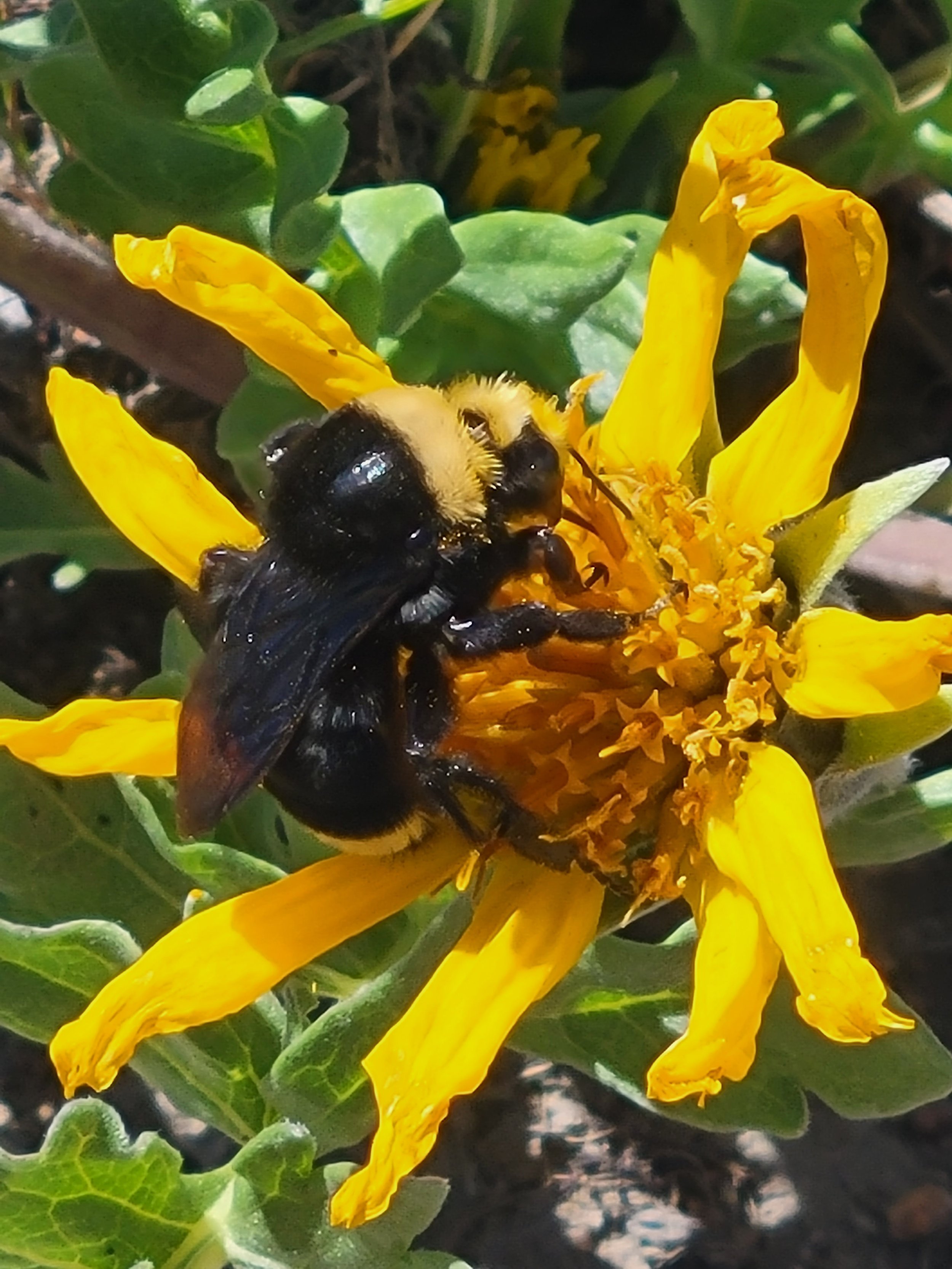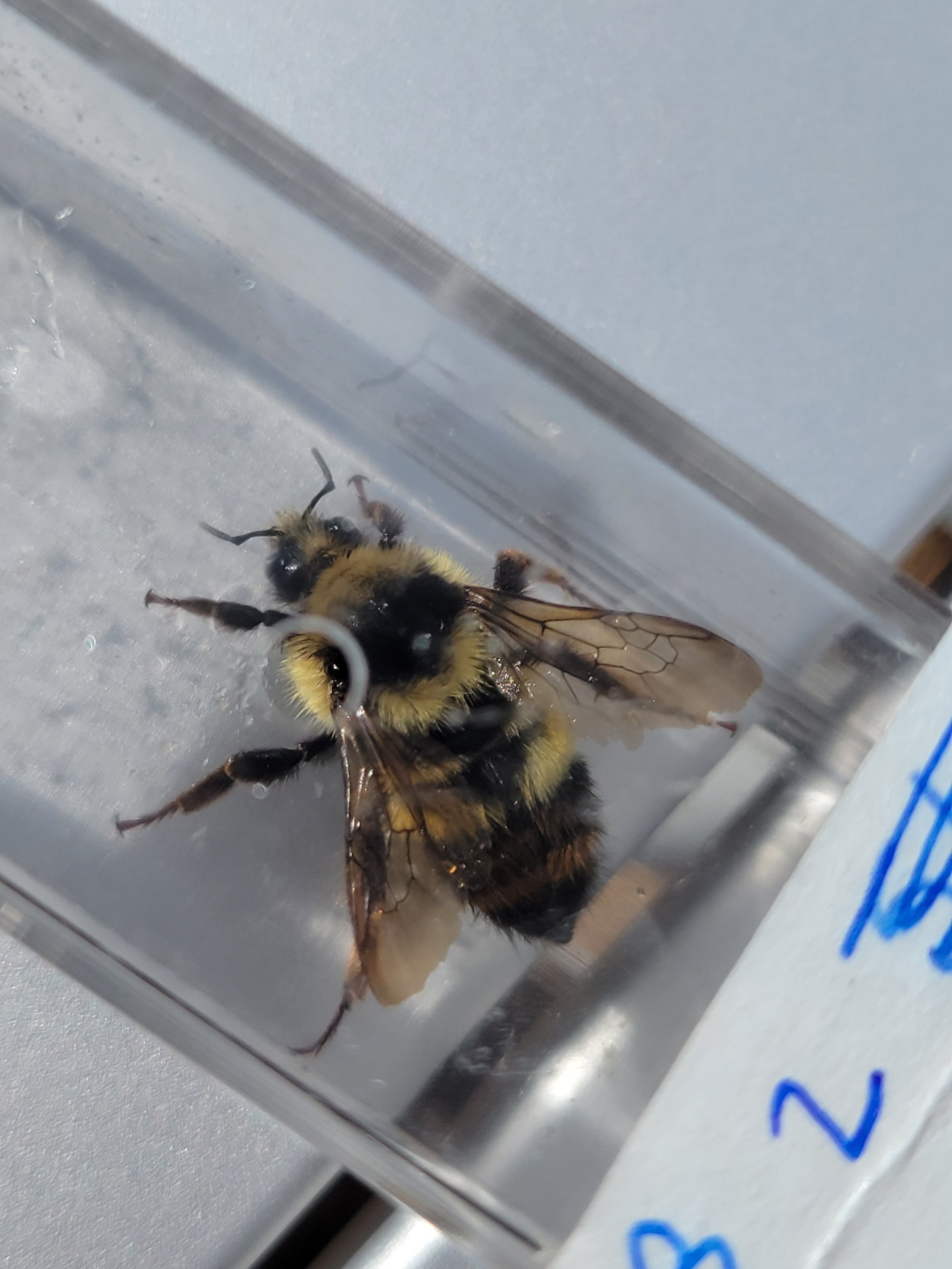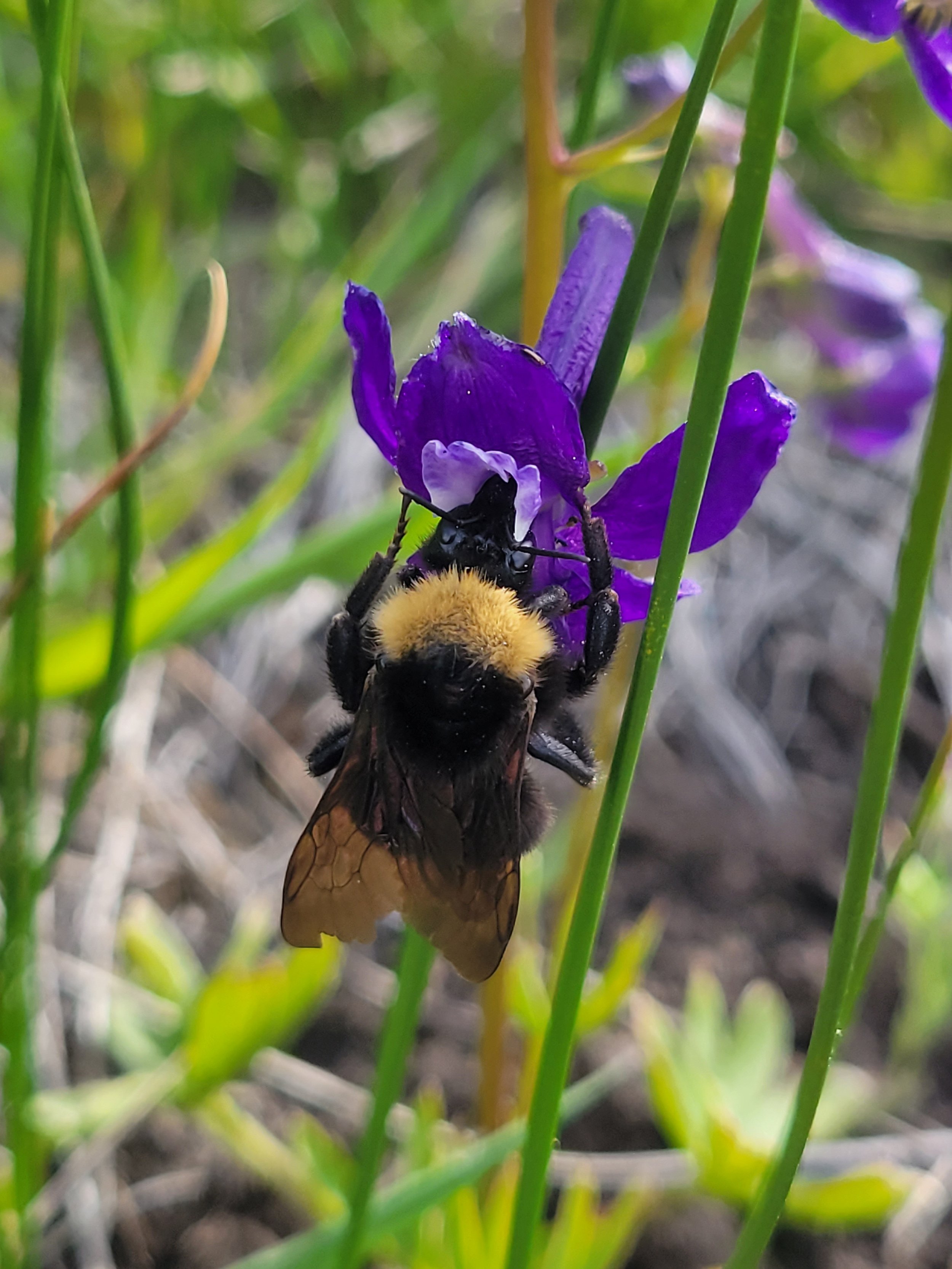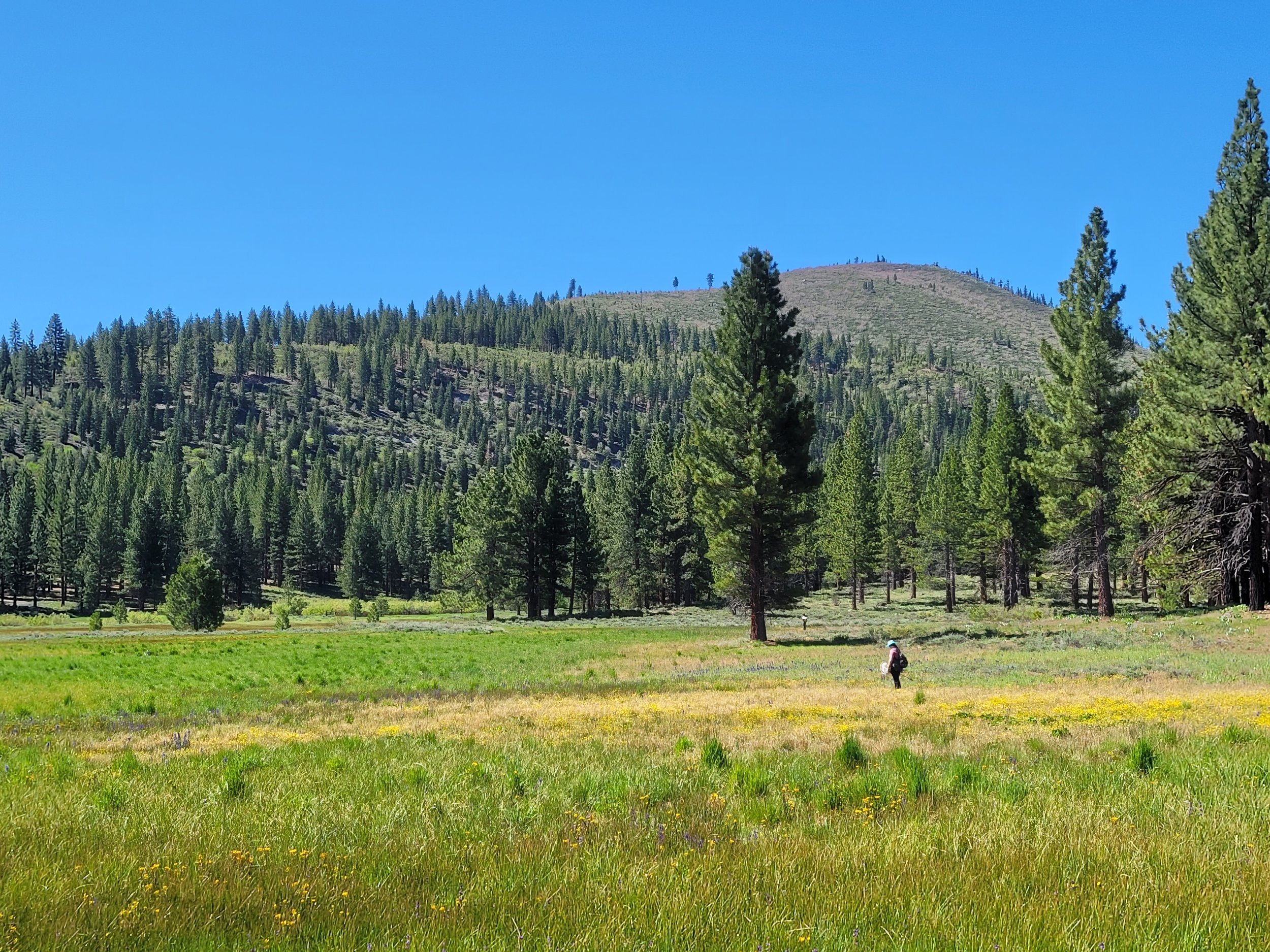We work with commercial and wild bees (bumblebees, mason bees, squash bees) using experimental approaches to investigate questions in animal behaviour and cognition from an ecological perspective.
We also address anthropogenic effects on bee cognition, behavior and health.
Cognition with complex rewards
Animals often make decisions between multiple, complex rewards. However, cognition is generally studied in relation to a single reward type, usually across a single dimension of quality. One of the primary goals of my research is to address cognitive variation in relation to complex rewards in order to gain a realistic understanding of cognition in natural scenarios.
These themes are prevalent in behavioral research with bees, where most of what we know about bee behavior comes from experiments using a simple sucrose solution as a proxy for “nectar”. In the wild, bees encounter a learning scenario much more nutritionally complex: they forage not only for nectar (carbohydrates) but also for pollen (protein) concurrently, visiting flowers that may offer one or both of these rewards. In addition, nectar is not a simple sucrose solution, but a cocktail of secondary compounds. My recent and ongoing research (started in Annie Leonard’s Lab at UNR) has addressed how bees perceive and learn about pollen (both alone and while foraging for nectar). Currently, the Muth Lab is working on how bees make decisions between flowers that vary in multiple axes of reward value (e.g. concentration vs variability, nectar vs pollen quality), and how prior experience with rewards of a particular quality bias future decisions. An additional ongoing research topic under this theme is how flowers’ nectar chemistry influences bee behavior; this topic has typically only been studied with single compounds, neglecting the ecologically realistic scenario of complex cocktails of chemicals with possible interactions. We study this both in experiments addressing bee behavior, and through measuring the chemistry of floral nectar.
Relevant papers:
MacNeill, F.T., Hunter, S.G., Muth, F.† & Sedio, B. (co-last authorship) (2025). Nectar metabolomes contribute to pollination syndromes. New Phytologist. https://doi.org/10.1111/nph.70217
Hemingway, C. T., DeVore, J., Muth, F. (2024) Economic foraging in a floral marketplace: Asymmetrically dominated decoy effects in bumblebees. Proceedings of the Royal Society: B. 291:20240843. https://doi.org/10.1098/rspb.2024.0843 pdf
Hemingway, C. T., Leonard, A. S., MacNeill, F. T., Pimplikar, S., & Muth, F. (2024). Pollinator cognition and the function of complex rewards. Trends in Ecology & Evolution. 39 (11), P1047-1058. https://doi.org/10.1016/J.TREE.2024.06.008 pdf.
Muth, F., Breslow, E., Leonard, A.S. (2022) Octopamine affects gustatory responsiveness and associative learning performance in bumble bees. In press at Apidologie, read on biorxiv here.
Muth, F., Philbin, C.S. (co-first author), Jeffrey, C.S, Leonard, A.S. (2022) Discovery of octopamine and tyramine in nectar and their effects on bumblebee behavior. iScience. 104765 https://doi.org/10.1016/j.isci.2022.104765. Open Access.
Hemingway, C.T. & Muth, F. (2022) Label-based expectations affect incentive contrast effects in bumblebees. Biology Letters. 18: 20210549. https://doi.org/10.1098/rsbl.2021.0549 pdf.
Muth, F., Breslow, P. R., Masek, P., & Leonard, A. S. (2018) A pollen fatty acid enhances learning and survival in bumblebees. Behavioral Ecology, Online ahead of print: https://doi.org/10.1093/beheco/ary111 pdf
Muth, F. Papaj, D.R. & Leonard, A.S. (2017) Multiple rewards have asymmetric effects on learning in bumblebees. Animal Behaviour 126, 123–133. doi:10.1016/j.anbehav.2017.01.010. pdf
Muth, F., Francis, J.S. & Leonard, A.S. (2016) Bees use the taste of pollen to determine which flowers to visit. Biology Letters, 12, 20160356. doi: 10.1098/rsbl.2016.0356. pdf.
Muth, F., Papaj, D.R. & Leonard, A.S. (2016). Bees remember flowers for more than one reason: Pollen mediates associative learning. Animal Behaviour 111, 93-100. pdf
Muth, F., Papaj, D.R. & Leonard, A.S. (2015). Colour learning when foraging for nectar and pollen: Bees learn two colours at once. Biology Letters 11, 20150628.
comparative cognition in wild bees























Photo credits: Jess Buelow
Species’ cognitive traits are shaped by their ecology, and even within a species, cognition can reflect the behavioural requirements of individuals with different roles. Wild bees offer a useful system in which to study questions in comparative cognition: they encompass around 20,000 species and vary in many aspects of their ecology. Even intra-specifically, bumblebees have a number of discrete roles (castes) with different ecological requirements. We are currently investigating intra- and inter-specific differences in cognition in wild bumblebees (see Figure on right).
Relevant papers:
Muth, F. (2021) Intra-specific differences in cognition: Bumblebee queens learn better than workers. Biology Letters. 17: 20210280. https://doi.org/10.1098/rsbl.2021.0280 pdf.
Muth, F., Tripodi, A.D., Bonilla, R. Strange, J.P., Leonard, A.S. (2021) No sex differences in learning in wild bumblebees. Behavioral Ecology. 32: 638-645. doi:10.1093/beheco/arab013. pdf.
Muth, F., Cooper, T., Bonilla, R.F. & Leonard, A.S. (2017) A novel protocol for studying bee cognition in the wild. Methods in Ecology and Evolution. 1-10. doi:10.1111/2041-210X.12852. pdf
Anthropogenic effects on cognition and bees
Wild bees are currently in decline, due to anthropogenic effects such as habitat loss and use of pesticides. As an animal that relies largely on learning to determine how to forage efficiently, understanding how the pesticides we use affect bumblebee cognition is critical to predicting how such use will affect bee behavior. Ongoing research in my lab focuses on pesticide effects on bee cognition, bee health, and the implications for pesticide policy and regulation.
Relevant papers:
Siviter, H., DrVore, J., Gray, L.K., Ivers, N.A., Lopez, E.A., Riddington, I.M., Stuligross, C., Jha, S., Muth, F., (2024). A novel pesticide has lethal consequences for an important pollinator, Science of The Total Environment, 952, 175935. https://doi.org/10.1016/j.scitotenv.2024.175935 pdf.
Richardson, L. I., Siviter, H., Jha, S.*, Muth, F. * (co-last authorship) (2024). Field- realistic exposure to the novel insecticide flupyradifurone reduces reproductive output in a bumblebee (Bombus impatiens). Journal of Applied Ecology. 00, 1-12. pdf. https://doi-org.ezproxy.lib.utexas.edu/10.1111/1365-2664.14706
Strang, G.C.†, Rondeau, S. † (co-first authorship), Baert, N., McArt, S., Raine, N.E. ‡, Muth, F. ‡ (co-last authorship) (2024). Field agrochemical exposure impacts locomotor activity in wild bumblebees. Ecology. 105 (6), e4310. https://doi.org/10.1002/ecy.4310 pdf.
Fisher, A., Tadei, R., Berenbaum, M., Nieh, J., Siviter, H., Crall, J., Glass, J., Muth, F., Liao, L., Traynor, K., DesJardins, N., Nocelli, R., Simon-Delso, N., Harrison, J.F. (2023). Breaking the cycle: Reforming pesticide regulation to protect pollinators, BioScience. biad088, https://doi.org/10.1093/biosci/biad088. pdf.
Siviter, H., Linguadoca, A., Ippolito, A., Muth, F. (2023) Pesticide licensing in the EU and protecting pollinators. Current Biology. 33: R44-R48. https://doi.org/10.1016/j.cub.2022.12.002. pdf.
Siviter, H., Pardee, G.L., Baert, N., McArt, S. Jha, S.* & Muth, F.* *co-last authorship (2023) Wild bees are exposed to low levels of pesticides in urban grasslands and community gardens. Science of the Total Environment. 858: 159839. https://doi.org/10.1016/j.scitotenv.2022.159839. pdf.
Siviter, H. & Muth, F. (2022) Exposure to the novel insecticide flupyradifurone impairs bumblebee feeding motivation, learning, and memory retention. Environmental Pollution. 307: 119575. https://doi.org/10.1016/j.envpol.2022.119575 pdf.
Siviter, H., Richman, S.K., Muth, F. (2021) Field-realistic neonicotinoid exposure has sub-lethal effects on non-Apis bees: A meta-analysis. Accepted to Ecology Letters.
Siviter, H., Johnson, A.K., Muth, F. (2021) Bumblebees exposed to a neonicotinoid pesticide make sub-optimal foraging decisions. Accepted to Environmental Entomology.
Fisher, A. & 14 Signatories (2021) Protect pollinators-reform pesticide regulations. Nature Correspondence. 595: 172. https://doi.org/10.1038/d41586-021-01818-x pdf.
Siviter, H. & Muth, F. (2020) Do novel insecticides pose a threat to beneficial insects? Proceedings of the Royal Society B: Biological Sciences. 287: 20201265. http://doi.org/10.1098/rspb.2020.1265. pdf.
Muth, F., Gaxiola RL, Leonard AS. (2020) No evidence for neonicotinoid preferences in the bumblebee Bombus impatiens. Royal Society Open Science. 7: 191883. http://dx.doi.org/10.1098/rsos.191883 . Open Access.
Muth, F., Francis, J.S. & Leonard, A.S. (2019) Modality-specific impairment of learning by a neonicotinoid pesticide. Biology Letters. 15: 20190359. http://dx.doi.org/10.1098/rsbl.2019.0359. pdf.
Muth, F. & Leonard, A.S. (2019) A neonicotinoid pesticide impairs foraging, but not learning, in free-flying bumblebees. Scientific Reports, 9: 4764. Open Access.




